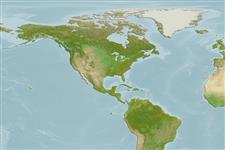Classification / Names
Common names | Synonyms | Catalog of Fishes (gen., sp.) | ITIS | CoL | WoRMS | Cloffa
Actinopterygii (ray-finned fishes) >
Ophidiiformes (Cusk eels) >
Bythitidae (Viviparous brotulas) > Brosmophycinae
Etymology: Ogilbia: Taken from Ogilby, 1887-1915, icthiologist and zoologist (Ref. 45335); mccoskeri: Named for Dr. John E. McCosker, California Academy of Sciences.. More on author: Schwarzhans, Nielsen.
Environment / Climate / Range
Ecology
Marine; reef-associated; depth range 0 - 5 m (Ref. 57883). Tropical, preferred ?
Western Central Atlantic: Panama.
Size / Weight / Age
Maturity: Lm ? range ? - ? cm
Max length : 6.5 cm SL male/unsexed; (Ref. 57883)
Short description
Morphology | Morphometrics
Dorsal
soft rays
(total): 80-86;
Anal
soft rays: 63 - 69;
Vertebrae: 43 - 45. This species is distinguished by the following: Vertebrae 11 + 32-34 = 43-45, dorsal fin rays 80-86, anal fin rays 63-69, outer pseudoclaspers long, sticklike, inner pseudoclasper absent, penis tapering, opercular spine with a single, sharp tip, scales on cheeks reduced to a small patch on upper cheek in 4-6 vertical rows; otolith length: height ratio 2.0, sulcus axis strongly inclined versus otolith axis (Ref. 57883).
Life cycle and mating behavior
Maturity | Reproduction | Spawning | Eggs | Fecundity | Larvae
Møller, P.R., W. Schwarzhans and J.G. Nielsen, 2005. Review of the American Dinematichthyini (Teleostei: Bythitidae). Part II. Ogilbia. Aqua J. Ichthyol. Aquat. Biol. 10(4):133-207. (Ref. 57883)
IUCN Red List Status (Ref. 115185)
CITES (Ref. 94142)
Not Evaluated
Threat to humans
Harmless
Human uses
More information
Common namesSynonymsMetabolismPredatorsEcotoxicologyReproductionMaturitySpawningFecundityEggsEgg development
Age/SizeGrowthLength-weightLength-lengthLength-frequenciesMorphometricsMorphologyLarvaeLarval dynamicsRecruitmentAbundance
ReferencesAquacultureAquaculture profileStrainsGeneticsAllele frequenciesHeritabilityDiseasesProcessingMass conversion
Tools
Special reports
Download XML
Internet sources
